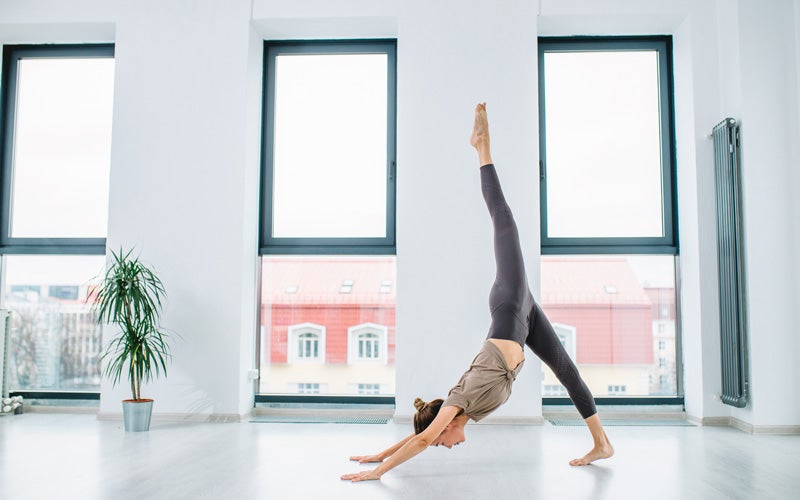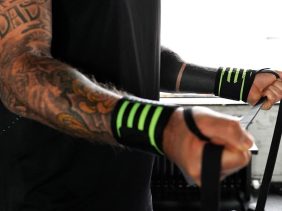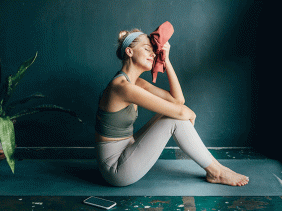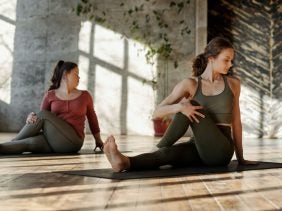Vinyasa yoga: A flow for the sport-minded yogis
 ©photographer
©photographer
What is vinyasa yoga? Is it the right practice for you? Find out more about this dynamic style of yoga as well as a video to guide you through the process below. And just in time for National Yoga Day, too!
Good news for yoga fans: This is the start of a series on yoga. We’ll spend the next several weeks doing deep dives into individual yoga poses and various yoga styles. Not your thing? Stay tuned for the rest of our articles, which aren’t going anywhere.
What is vinyasa yoga?
Vinyasa yoga is all about syncing your movements to the rhythm of your breath. With each inhalation and exhalation, you move fluidly from one pose to the next. In every new pose, the goal is to breathe a little more deeply than in the previous one.
One of yoga’s central tenets is the belief that “the journey is its own reward.” There are no pauses during vinyasa yoga, only fluid transitions, and they are just as important as the poses they move you to. As you focus on your inhalations and exhalations, your breath determines the rhythm at which you move. When you practice vinyasa yoga, movement and breathing often become one.
Poses are only held for a relatively short period of time during vinyasa yoga. Each transition is linked to either an inhalation or exhalation. You may breathe more or less depending on the rhythm and difficulty of a class.
Strictly speaking, vinyasa yoga is not a type of yoga in its own right. The word “vinyasa” is simply used to describe moving to the rhythm of your breath. Yoga styles like ashtanga and hatha yoga as well as many other varieties are often practiced in vinyasa.
Due to the lack of breaks, the flows, or sequences of postures, in vinyasa yoga are often faster and get you more sweaty than other yoga practices.
Once you’re familiar with the different yoga poses, you’ll be able to better focus on breathing and quickly discover that your vinyasa flow can be a form of meditation in motion. Keep your focus on yourself rather than the world around you, and remind yourself to bring your attention back whenever you feel your eyes begin to wander.
Our tip: Staying hydrated is essential during any physical activity — even yoga. Hot drinks are especially good for your digestive system, and a good herbal tea will warm you up for your practice and get you the fluids you need. Our Tea Sets are specifically designed to help you drink enough water.
Vinyasa Flow: yoga workouts
You’ll find the same poses in many different styles of yoga, from hatha to ashtanga. Odds are you’ll end up in a downward facing dog no matter what class you’re in. The difference between them and vinyasa yoga practice is in the way and speed at which you move through the poses, and whether or not you’re synchronizing your breath to your flow.
It’s much easier to move through a vinyasa yoga flow when you’re already familiar with the basic poses. That way, you can focus on the sequence itself, your body’s alignment, and coordinating your breathing to your flow.
Overall, vinyasa yoga classes can vary a lot in style and structure. Though the poses are the same from one practice to the next, the sequence in which they appear may differ. For example, one yoga class may start a vinyasa flow by beginning in warrior one, where another might skip directly to warrior two or three and return to warrior one later on. Which poses are used and in which sequences they’re arranged will depend on the teachers intentions for a particular class or flow.
Benefits of vinyasa yoga
A lot of people consider this vinyasa yoga to be moving meditation, in that it trains both your body and mind. Although it can be strenuous, remaining relaxed is key to reaping its benefits.
The point isn’t to work so hard that you lose your breath. Being able to breathe fully throughout the whole sequence will enable you to move more fluidly and can make it easier to endure more pain. And if you can’t breathe evenly, that might be a sign that you should slow down and take a child’s pose (at least until your breathing is back to normal).
Learn to know your limits and accept them. In each vinyasa flow, you can also adjust each posture according to your needs. It’s best to ask your yoga teacher which variations or inverted postures are right for you, especially if you’re recovering from an injury or have chronic pain.
A regular yoga practice may result in benefits like:
- improved strength and fitness
- improved flexibility and balance
- improved concentration
- increased ability to relax
- increased ability to be present
Here’s an at-home vinyasa workout
In this video, Jenny, aka Yoflaminga, has created a flow that mobilizes the spine, shoulders, and hips. It’s a whole body stretch and great ab workout at the same time.
Jenny also provides adjustments and modifications for each movement and asana so you can easily adapt the flow to your needs. Both beginners and experienced yogis alike will appreciate this session.
Our tip: We encourage you to watch the video before your first try following along. This will give you an overview of the poses to expect during your workout. You’ll know what’s coming and will be able to fully concentrate on your breathing during the practice.
Is vinyasa yoga right for me?
This dynamic style of yoga is right for you if you want to sweat during a workout and are ready to concentrate. It’s all about applying yourself fully to each pose, but also knowing your limits and when it’s time to slow down or stop.
As with any new activity, it’s best to start with a beginner class to see how it all works.
In general, it’s good to have some familiarity with the basic yoga asanas before moving on to more intense sessions.
At first, you may find yourself feeling a little overwhelmed, and wondering how it all works, why you aren’t moving faster, and if you’re doing everything right. Thinking about all these things makes it difficult to concentrate on what’s important during your practice — your breathing and level of focus.
If you find yourself distracted by these thoughts, slowing down is one of the best ways to cut out the noise and recenter your focus. If you feel like you need a break, take one. That’s what the child’s pose is for!
Even the most seasoned yogis struggle with this from time to time, so don’t let it spoil your session, or worse, put you off yoga!
We recommend beginning your practice in a yoga class under the watchful eye of a teacher, who can ensure that your form is correct so that you’re not putting yourself at risk of injury. Once you have mastered the asanas and principles, you can practice whenever and wherever you want.
And now: Enjoy the video!
Vinyasa yoga: Our conclusion
- The word vinyasa is used to describe the linking of movements and breathing.
- During a session, fluid movements bring you from one pose to the next.
- The level of intensity of a yoga practice depends on its rhythm.
- The benefits of yoga include increased strength, flexibility, awareness, and concentration.
- Vinyasa is not a school of yoga but rather a dynamic style. Ashtanga yoga and hatha yoga can be practiced in the vinyasa style.
Sources for this article
We at foodspring use only high-quality sources, including peer-reviewed studies, to support the facts within our articles. Read our editorial policy to learn more about how we fact-check and keep our content accurate, reliable, and trustworthy.





























